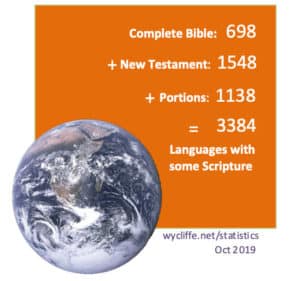Wycliffe Bible Translators has released its latest annual figures on the progress being made in Bible translation worldwide. Among the highlights are that 698 languages now have the complete Bible (up from 683 in 2018), and that 1,548 languages have a complete New Testament (up from 1,534). A further 1,138 have some translated portions of the Bible (up from 1,133).
 Encouragingly, there is also active translation or preparatory work going on in 2,617 languages in 161 countries. Wycliffe and its partner organization SIL are involved in about three-quarters of this work.
Encouragingly, there is also active translation or preparatory work going on in 2,617 languages in 161 countries. Wycliffe and its partner organization SIL are involved in about three-quarters of this work.
“These are encouraging figures, and represent the tremendous work that translation teams are doing across the world,” says Peter Brassington, who compiles the statistics and helps Wycliffe to analyze them. “Changes year to year don’t always look dramatic on the surface, but Bible translation requires dedicated, long-term effort, and the translations finished now often started many years ago.
“I joined Wycliffe in 1996: the number of languages in which there is a complete Bible has doubled in that time.”
The number of active languages—7,353—now includes sign languages. Although there are 3,384 languages with some portions of the Bible, there are 3,969 (covering 252 million people) with not even a single verse.
As the statistics demonstrate, there is still much work to do; nearly 1.5 billion people, or 1 in 5, do not have the Bible in the language they understand best. That’s why Wycliffe continues to work with urgency to translate God’s word into all remaining languages.
Note: The data is current as of Oct. 1, 2019, and is compiled from data provided through progress.bible by Wycliffe organizations, SIL International, United Bible Societies and other partners. Population data is based on available information about first-language speakers in SIL’s Ethnologue.

